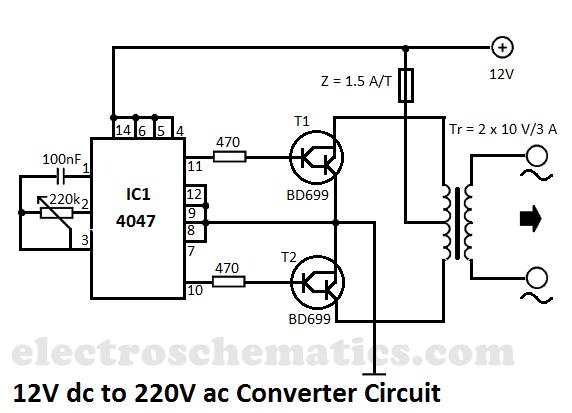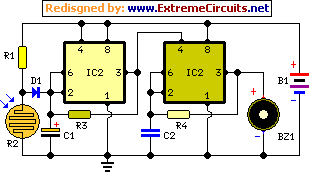
12V to 220V converter circuit Schematic Diagram

This DIY 12V to 220V voltage converter is built with the CMOS 4047, which serves as the main component of this compact voltage converter that transforms 12V DC into 220V AC. The 4047 is configured as an astable multivibrator, generating a symmetrical rectangular signal at pins 10 and 11. This signal is amplified by two Darlington transistors before reaching the secondary coil of a transformer (2x10V / 60VA). The output at the main voltage converter transformer terminals will be 220V. The output frequency can be adjusted between 50Hz and 400Hz using potentiometer P1. Although this device is not classified as a professional DC to AC converter, it can be effectively utilized with certain home appliances.
The circuit design of this DIY voltage converter employs a CMOS 4047 integrated circuit, which is widely recognized for its versatility in generating square wave signals. In this application, the 4047 operates in astable mode, producing a continuous output waveform that serves as the basis for converting the input DC voltage to AC voltage.
At the heart of the circuit, the 4047's output pins (10 and 11) deliver a symmetrical rectangular waveform. The frequency of this waveform can be fine-tuned through the use of resistors and capacitors connected to the 4047, allowing for a flexible output frequency that can range from 50Hz to 400Hz. This feature is particularly useful for adapting the converter to different types of appliances that may require specific operating frequencies.
The generated signal is then fed into two Darlington transistor pairs, which are configured to amplify the current of the signal. This amplification is crucial for driving the transformer effectively, ensuring that sufficient power is delivered to the load. The transformer used in this design is a step-up transformer rated at 2x10V and 60VA, which is capable of converting the low voltage signal into a higher voltage output of 220V AC at its secondary terminals.
The transformer plays a pivotal role in isolating the high voltage output from the input circuit, providing safety during operation. The output voltage can be utilized to power various household appliances that operate on AC voltage, although it is essential to note that this converter is not intended for professional applications and may not meet all regulatory standards for commercial devices.
Overall, this DIY voltage converter represents an accessible solution for hobbyists and enthusiasts looking to create their own power conversion systems for light-duty applications. Proper attention to component ratings and safety precautions is advised to ensure reliable and safe operation.This DIY 12V to 220V voltage converter is build with CMOS 4047 that is the main component of this small voltage converter that transforms a 12V DC into 220V AC. 4047 is used as a astable mutivibrator, at pins 10 and 11 will have a symmetrical rectangular signal wich is amplified b 2 Darlington transistors and finally reach the secondary coil of ma
ins transformer ( 2x10V / 60VA ). At the main voltage converter transformer terminals it will be 220V. With the help of P1 the output frequency can be adjusted between 50Hz to 400Hz. Although this is not part of any professional dc ac converters it can be used quite effective on some home appliances. 🔗 External reference
The circuit design of this DIY voltage converter employs a CMOS 4047 integrated circuit, which is widely recognized for its versatility in generating square wave signals. In this application, the 4047 operates in astable mode, producing a continuous output waveform that serves as the basis for converting the input DC voltage to AC voltage.
At the heart of the circuit, the 4047's output pins (10 and 11) deliver a symmetrical rectangular waveform. The frequency of this waveform can be fine-tuned through the use of resistors and capacitors connected to the 4047, allowing for a flexible output frequency that can range from 50Hz to 400Hz. This feature is particularly useful for adapting the converter to different types of appliances that may require specific operating frequencies.
The generated signal is then fed into two Darlington transistor pairs, which are configured to amplify the current of the signal. This amplification is crucial for driving the transformer effectively, ensuring that sufficient power is delivered to the load. The transformer used in this design is a step-up transformer rated at 2x10V and 60VA, which is capable of converting the low voltage signal into a higher voltage output of 220V AC at its secondary terminals.
The transformer plays a pivotal role in isolating the high voltage output from the input circuit, providing safety during operation. The output voltage can be utilized to power various household appliances that operate on AC voltage, although it is essential to note that this converter is not intended for professional applications and may not meet all regulatory standards for commercial devices.
Overall, this DIY voltage converter represents an accessible solution for hobbyists and enthusiasts looking to create their own power conversion systems for light-duty applications. Proper attention to component ratings and safety precautions is advised to ensure reliable and safe operation.This DIY 12V to 220V voltage converter is build with CMOS 4047 that is the main component of this small voltage converter that transforms a 12V DC into 220V AC. 4047 is used as a astable mutivibrator, at pins 10 and 11 will have a symmetrical rectangular signal wich is amplified b 2 Darlington transistors and finally reach the secondary coil of ma
ins transformer ( 2x10V / 60VA ). At the main voltage converter transformer terminals it will be 220V. With the help of P1 the output frequency can be adjusted between 50Hz to 400Hz. Although this is not part of any professional dc ac converters it can be used quite effective on some home appliances. 🔗 External reference





